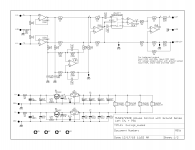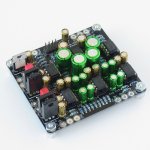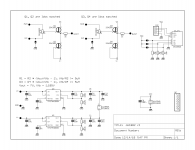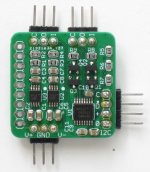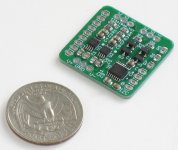Almost there with my project.
MUSES72320 volume control of course flanked with quad stereo inputs switched by ADG1439's, stereo peak level meters and RMS responding linear-in-log loudness meters with about 110dB response range.
Not shown is the micro doing the brainwork and the level display, still some work to go, it will eventually be integrated with the amplifier for power control and power metering. Also it can do stuff like live normalisation and limiting, but for most of my use that will be a play tool than anything useful.
Feature wise mostly overkill, just made to push the boundaries of technique. The business end of the level meter is made involving SOT-563 dual transistors which were a learning experience to handle without paste.
I will probably build a second one to use as a general purpose measurement interface.
---
Q: Has anyone tried to omit the cap shown at the opamp inputs for bipolar operation?
I have the OPA1642 ready to go in now that all functional parts are tested though, so maybe not so important. Currently there's the bipolar opamp there but I'm wondering if the DC blocker at that position is really just the fruit of a perfecting engineer, or if it's genuinely a detail that will degrade performance.
MUSES72320 volume control of course flanked with quad stereo inputs switched by ADG1439's, stereo peak level meters and RMS responding linear-in-log loudness meters with about 110dB response range.
Not shown is the micro doing the brainwork and the level display, still some work to go, it will eventually be integrated with the amplifier for power control and power metering. Also it can do stuff like live normalisation and limiting, but for most of my use that will be a play tool than anything useful.
Feature wise mostly overkill, just made to push the boundaries of technique. The business end of the level meter is made involving SOT-563 dual transistors which were a learning experience to handle without paste.
I will probably build a second one to use as a general purpose measurement interface.
An externally hosted image should be here but it was not working when we last tested it.
---
Q: Has anyone tried to omit the cap shown at the opamp inputs for bipolar operation?
I have the OPA1642 ready to go in now that all functional parts are tested though, so maybe not so important. Currently there's the bipolar opamp there but I'm wondering if the DC blocker at that position is really just the fruit of a perfecting engineer, or if it's genuinely a detail that will degrade performance.
Just in case anyone is interested there is a arduino libary for the MUSE chip now at : GitHub - qhris/Muses72320: Muses72320 library for Arduino
caps in path ?
I'm having trouble finding a schematic for modules people are building with the Muses 72320, among the 42 pages or so.
The application diagrams on the data sheet show caps on the input and output for attenuation and boost mode. I assume these are DC blocking caps.
Are these caps necessary? Given the audio community hates caps in the signal path, I'm having trouble figuring out how everyone is so in love with this device if it requires 2 blocking caps and none of the posts make much mention of them that I can see. I therefore suspect those caps aren't required and rather the chip is being used without the caps.
Thanks for any replies.
I'm having trouble finding a schematic for modules people are building with the Muses 72320, among the 42 pages or so.
The application diagrams on the data sheet show caps on the input and output for attenuation and boost mode. I assume these are DC blocking caps.
Are these caps necessary? Given the audio community hates caps in the signal path, I'm having trouble figuring out how everyone is so in love with this device if it requires 2 blocking caps and none of the posts make much mention of them that I can see. I therefore suspect those caps aren't required and rather the chip is being used without the caps.
Thanks for any replies.
I use DC blocking capacitors - Nichicon MUSE ES - and sleep well at night  The caps, I understand, are mainly to prevent clicks when changing volume. You can probably leave them out if you can make sure (trim?) opamps have no DC offset.
The caps, I understand, are mainly to prevent clicks when changing volume. You can probably leave them out if you can make sure (trim?) opamps have no DC offset.
Attached is the schematic for one channel. Full schematic and other documentation can be found here.
Attached is the schematic for one channel. Full schematic and other documentation can be found here.
Attachments
Last edited:
Hi Alex,
Thanks for that, I'll have a look later today. The good thing about a serial cap is, one could plan for it and try it out beforehand by merely shorting the connection. If it's giving trouble, remove the short and add the cap. I want to use it as a volume control for a tubed single-ended preamp, but I want to be able to put the same control later into balanced gear. And I have a nice shiny new BeagleBone Black for control and an LCD touchscreen.
And now to throw more fuel on the fire, does anyone have good experience with the Maxim MAX5437 as an alternative to the Muses chip? I spotted it in some pics of a really top end piece of kit.
Cheers,
W/
Thanks for that, I'll have a look later today. The good thing about a serial cap is, one could plan for it and try it out beforehand by merely shorting the connection. If it's giving trouble, remove the short and add the cap. I want to use it as a volume control for a tubed single-ended preamp, but I want to be able to put the same control later into balanced gear. And I have a nice shiny new BeagleBone Black for control and an LCD touchscreen.
And now to throw more fuel on the fire, does anyone have good experience with the Maxim MAX5437 as an alternative to the Muses chip? I spotted it in some pics of a really top end piece of kit.
Cheers,
W/
No experience with MAX5437, but AFAIK it is a linear digital pot. For volume control, it should work well as a negative feedback element for, say, an opamp. To use it as attenuator, a log pot would be preferable. I've done some work with DS1882, a very nice digital pot that I believe was used in some PassLabs amplifiers. It seems it doesn't like to be loaded heavily, but otherwise works fine.Maxim MAX5437 as an alternative to the Muses chip
Attachments
Thank you Wayne!
Very interesting. What the resistor is for? Couldn't you just short it instead?Instead of an input capacitor, which destroys the sound, you can put a 500 ohm resistor.
Last edited:
Curiouser and curiouser! Did you find the reason for cracking? Was there any DC at output and/or input?
I understand meldano's board has no active analog circuitry (e.g. opamps) and no blocking capacitors; it just uses one digital pot per channel for attenuation and ignores the feedback pots. Used like that, MUSES72320 should be functionally similar to an unbuffered DS1882 or any other digital pot. I would not expect any cracking unless DC was present - hence my suggestion two posts above to remove the caps if there his no DC - and even with DC sound would be heard.
I understand meldano's board has no active analog circuitry (e.g. opamps) and no blocking capacitors; it just uses one digital pot per channel for attenuation and ignores the feedback pots. Used like that, MUSES72320 should be functionally similar to an unbuffered DS1882 or any other digital pot. I would not expect any cracking unless DC was present - hence my suggestion two posts above to remove the caps if there his no DC - and even with DC sound would be heard.
I have no experience with meldano's boards - so someone who has please correct me - but the datasheet for MUSES72320 shows (page 10, application circuits) 10uF input coupling capacitors (Cin) for the JFET input opamps and 22-47uF for bipolar input opamps. This is probably a minimum.
Cin and the 20kOhm input impedance of the MUSES digital attenuators form a high-pass filter (HPF) with the corner frequency Fc=1/(2*Pi*Rin*Cin). For example, for Cin=10uF and Rin=20k, Fc=1/(2*Pi*2e4*1e-5)=0.8Hz. You want Fc to be well below 1/10 (some say below 1/100 for better stereo imaging) of the lowest frequency you want to reproduce.
Having said this, Theodosis O. above mentioned that input capacitor was "destroying the sound". I am curious to know what happened. Capacitors can distort - see, for example, Cyril Bateman's work - but I am not sure if Theodosis O. referred to that distortion.
Output coupling capacitors seem to be required if the downstream amplifier sources/sinks current into the MUSES chip. The application circuit includes them for bipolar input opamps (nanoamp input current) but skips them for JFET input opamps (picoamps). The value should probably be equal or bigger than Cin as long as your downstream amplifier has input impedance not less than Rin. Note that the application circuit shows 10uF for 470k load, which makes HPF with Fc=0.03Hz.
Cin and the 20kOhm input impedance of the MUSES digital attenuators form a high-pass filter (HPF) with the corner frequency Fc=1/(2*Pi*Rin*Cin). For example, for Cin=10uF and Rin=20k, Fc=1/(2*Pi*2e4*1e-5)=0.8Hz. You want Fc to be well below 1/10 (some say below 1/100 for better stereo imaging) of the lowest frequency you want to reproduce.
Having said this, Theodosis O. above mentioned that input capacitor was "destroying the sound". I am curious to know what happened. Capacitors can distort - see, for example, Cyril Bateman's work - but I am not sure if Theodosis O. referred to that distortion.
Output coupling capacitors seem to be required if the downstream amplifier sources/sinks current into the MUSES chip. The application circuit includes them for bipolar input opamps (nanoamp input current) but skips them for JFET input opamps (picoamps). The value should probably be equal or bigger than Cin as long as your downstream amplifier has input impedance not less than Rin. Note that the application circuit shows 10uF for 470k load, which makes HPF with Fc=0.03Hz.
With the input capacitor the dynamics suffer. The sound was not alive. Maybe a Mundorf Supreme Silver Gold Oil would be better, but who wants to know. 
I saw the use of the resistor in .pdf in post #94
My setup is Esoteric K-03 CD > Muses volume > Salas DCG3 preamp and there was problem, but maybe you have no problem with your setup.
I saw the use of the resistor in .pdf in post #94
My setup is Esoteric K-03 CD > Muses volume > Salas DCG3 preamp and there was problem, but maybe you have no problem with your setup.
Last edited:
Thanks again,
Ah too bad, I really wanted to use this chip to avoid any passive parts in the direct signal path to avoid sound coloration or loss.
Indeed if one need 10 to 47 uF capacitor, there is not too much choice at small price : so electrolytic cap ! Maybe the BP Muse from Nichicon or two Elna in back to back conf (-++- serie)... Or signal transformer as the littliest Lundhals ?
Hummm I'm asking myself how they made it in the Pass High End pre that use this chip iirc, XP30 or XS pre ?
Are there testimonials from Meldano's kit about that please if you read me ?
regards
Ah too bad, I really wanted to use this chip to avoid any passive parts in the direct signal path to avoid sound coloration or loss.
Indeed if one need 10 to 47 uF capacitor, there is not too much choice at small price : so electrolytic cap ! Maybe the BP Muse from Nichicon or two Elna in back to back conf (-++- serie)... Or signal transformer as the littliest Lundhals ?
Hummm I'm asking myself how they made it in the Pass High End pre that use this chip iirc, XP30 or XS pre ?
Are there testimonials from Meldano's kit about that please if you read me ?
regards
- Home
- Source & Line
- Analog Line Level
- MUSES 72320 electronic volume
